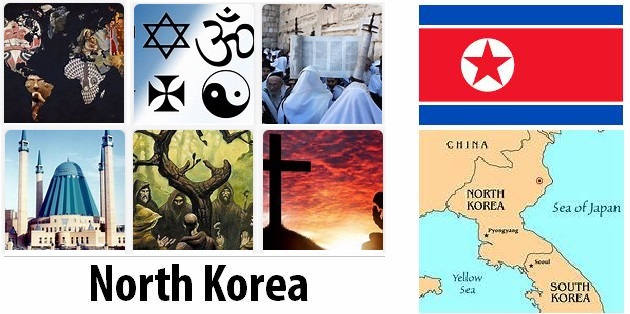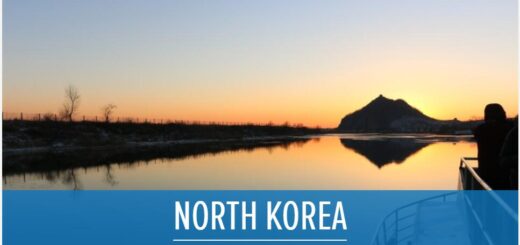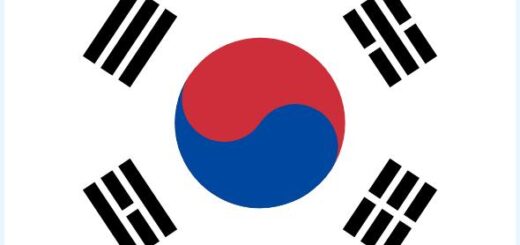North Korea Religion
The constitution promises freedom of religion, but in reality no one exists. At the same time as there are formally approved societies, everyone who practices religion is in practice considered enemies of the state. Believers are persecuted and imprisoned, and may also be executed.
The law prohibits the use of religion as a means in the service of foreign powers, to damage the state or disrupt social order. A few shrines and worship services are allowed as display objects for foreign visitors.
The officially approved communities are found in Buddhism, Christianity and the mixed religion chondogyo (see below).
Buddhism came to Korea with Chinese missionaries and became the dominant religion in the 300s. From the end of the 1300s, it was partially suppressed by Chinese wisdom doctrine Confucianism, which emphasizes the importance of education and obedience to the authorities. Christianity was brought to Korea in the 18th century. In the 19th century, chondogyo was founded with elements of Christianity, Buddhism, Confucianism, Daoism, ancestral worship and religious belief. The strongly nationalistic features of North Korean politics – an endeavor to rely on their own forces in all things – can be traced to chondogyo.
The Bible is a banned book in North Korea. According to several reports in recent years, people have been executed for owning or distributing Bibles.
Traditional religions still live in ways of thinking and attitudes, even though more than two-thirds of North Koreans are said to be non-religious.
- Countryaah: Population statistics for 2020 and next 30 years in North Korea, covering demographics, population graphs, and official data for growth rates, population density, and death rates.
Population composition
As in South Korea, the population composition is very homogeneous. 99% of the population are Koreans. Chinese are the largest minority in both states. The data for North Korea’s population are currently only based on estimates. About 3 million people fled to the south of the peninsula after World War II, mainly during the Korean War.
Population distribution
North Korea is 20% bigger than South Korea, but it has not even half as many residents. The population distribution over North Korea is very different because of the predominantly mountainous landscape. The plains in the west of the country are densely populated. Two thirds of the residents live in cities. The degree of urbanization is lower than in South Korea. The standard of living in North Korea is much lower than that in South Korea. The living conditions in the countryside are arguably even worse than in the cities. There were repeated famines in North Korea in the 1990’s. The educational offer hardly corresponds to that of South Korea. Pyongyang University is the only university in the country. However, the capital was generously expanded with monumental buildings.
2013
December
Jang Song-Thaek falls into disgrace
Kim Jong-Un’s uncle Jang Song-Thaek gets rid of his posts in the party leadership and the National Defense Commission. He loses his membership in the party. He is said to have committed criminal acts. A few days later, on December 13, the North Korean State News Agency reports that Jang has been executed. However, his wife, Kim Kyong-Hui, sister of Kim Jong-Il, is said not to have fallen into disgrace.
November
mass Execution
According to a report released in media in the US and South Korea, some 80 people are executed publicly in seven cities, in what case are the first mass executions since Kim Jong-Un became the country’s leader. Among the crimes that should have been behind the executions are the possession of Bibles, South Korean films or pornographic material.
October
Disallowed with children abroad
North Korean diplomats and trade workers are reportedly ordered to send their children home from schools abroad.
Increased nuclear weapons activity
According to an analysis of satellite imagery, an institute in Washington DC in the United States states that activity has increased at North Korea’s headquarters for underground test blasts. This may be preparation for a new nuclear test. A reactor at the Yongbyon nuclear power plant is also believed to be running again.
September
The work in Kaesong resumes
North and South Korea decide to resume work in the Kaesong industrial zone on September 16.
June
South Korean websites are hacked
A number of South Korean websites on the internet – both official and media – are hacked in a coordinated attack on the anniversary of the start of the Korean War. The perpetrators are unknown. On the chopped pages are messages of North Korean leader Kim Jong-un’s excellence. A similar attack occurred in March.
May
Ban Ki-Moon appeals to nuclear weapons
After North Korea conducted tests with short-range missiles, UN Secretary-General Ban Ki-Moon appeals for North Korea to resume dialogue on its nuclear weapons program.
April
America is sentenced to labor camps
US citizen Kenneth Bae is sentenced to 15 years of labor camp, accused of planning to overthrow the government (see November 2012).
Suspended access to industrial facilities
North Korea no longer allows South Korean workers to gain access to the Kaesong industrial plant. A few weeks later, the 50,000 North Koreans working at various South Korean companies in Kaesong are also not allowed to go to work (see Industry).
Yongbyon is active again
North Korea’s regime states that it will resume operations at the Yongbyon nuclear power plant. The reactor was closed in 2007 after an aid settlement.
New nuclear weapons plan
Parliament adopts plan to increase the importance of nuclear weapons in North Korea’s defense;
Pak Pong-Ju becomes Prime Minister
Pak Pong-Ju becomes new prime minister. He was prime minister also in 2003-2007 but then had to go after dissatisfaction with his economic reform policy.
March
The UN is investigating human rights
The United Nations Human Rights Council (UNHRC) decides to investigate serious human rights violations in North Korea and whether these are so-called crimes against humanity (see Political system).
War state with South Korea
North Korea states that artillery and robots have been prepared for attack against US military bases in Hawaii, Guam and the US mainland. All non-aggression agreements with Seoul are terminated and Pyongyang announces that the country is entering into a “state of war” with South Korea.
South Korea and the United States in military exercise
The US and South Korea embark on an annual military exercise with 40,000 soldiers. North Korea reacts strongly to the exercise and the new UN sanctions.
The UN adopts financial sanctions
The UN Security Council agrees to impose new economic sanctions on North Korea. Sanctions include, among other things, transfers of money and travel for diplomats. It is the fifth resolution adopted since 2006, as a result of North Korea’s nuclear weapons and robot programs.
February
A third nuclear test
On February 12, North Korea tests a nuclear charge. It is the country’s third nuclear test; they were previously performed in 2006 and 2009.
January
The UN Security Council adopts resolution
The UN Security Council adopts a resolution as a result of the rocket launch.




